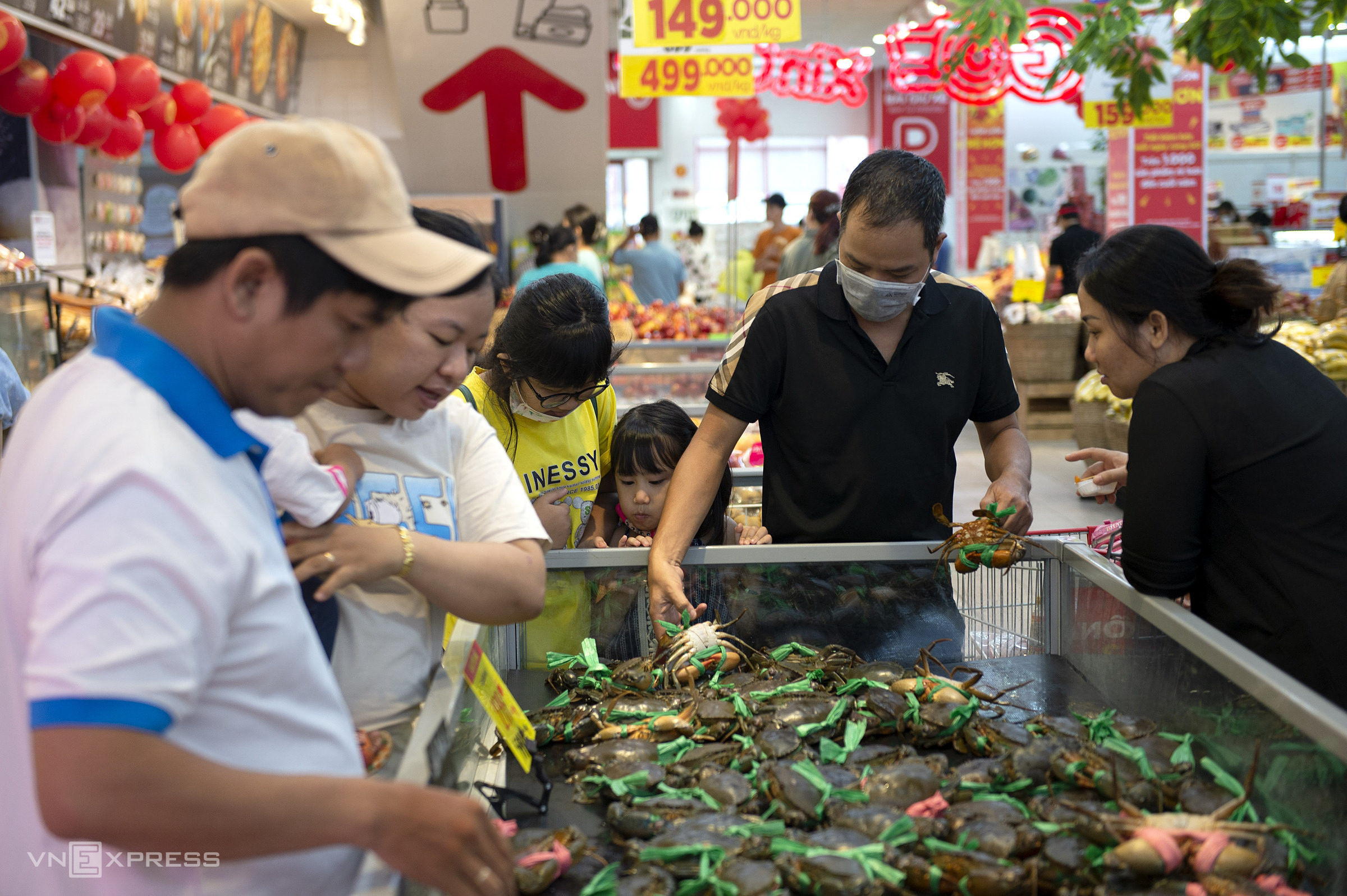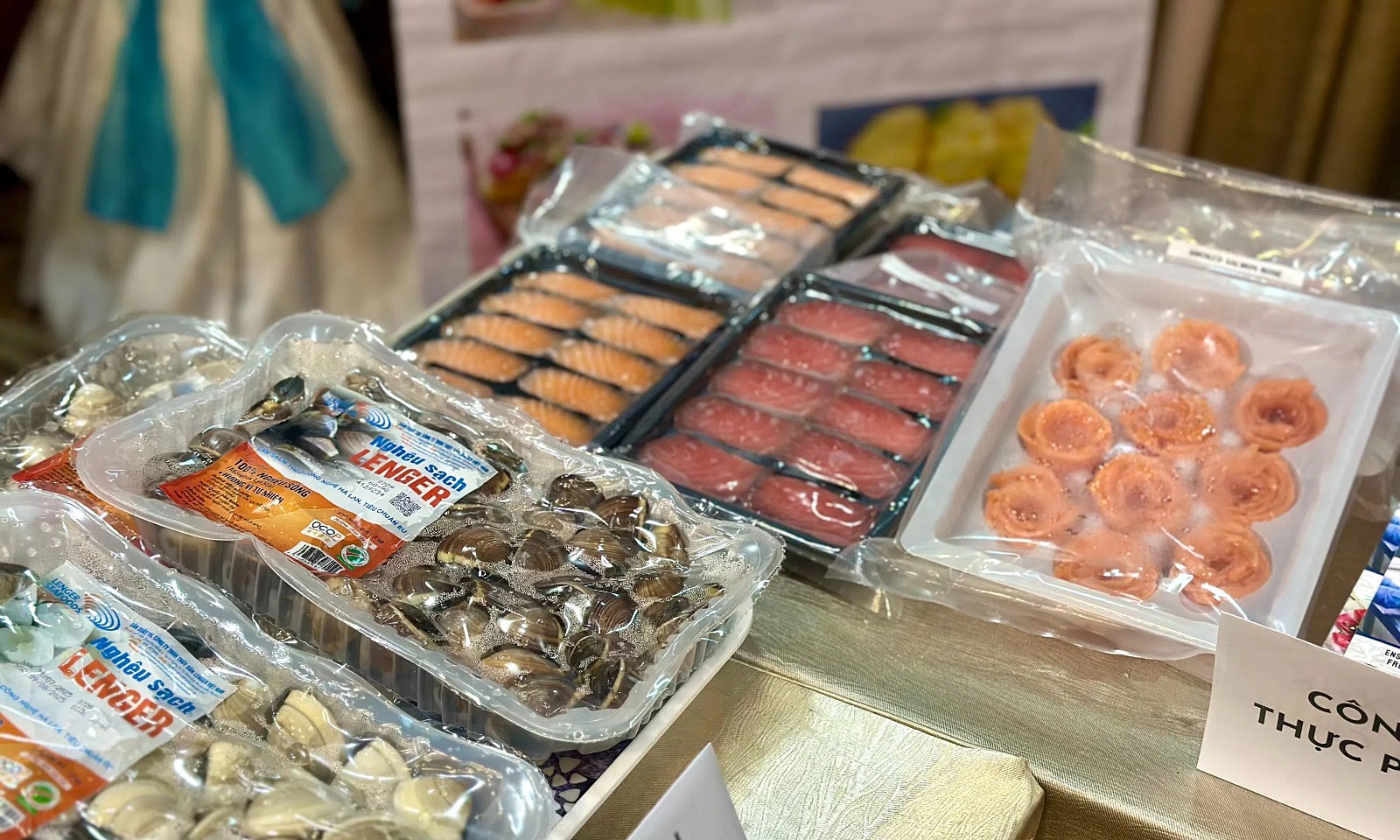Seafood sales at Saigon Co.op nearly doubled in the first half of the year. Business director Vo Tran Ngoc said 90% of the supply is domestic, with pangasius, shrimp, and processed products being popular choices.
"Seafood demand has increased sharply, especially in the past two months, as consumers are shifting to these products due to livestock disease outbreaks," Ngoc said at the "Promoting Domestic Seafood Consumption" conference organized by the Ministry of Industry and Trade and the Vietnam Association of Seafood Exporters and Processors (VASEP) on 1/8/2025.
During the same period, Lotte Mart Vietnam also recorded a 20% increase in seafood purchases. Nguyen Thi Tuyet Anh, head of the seafood department, said the sector has seen steady growth in both revenue and profit in recent years, with over half of the purchased volume coming from domestic sources.
 |
Sea crabs for sale in a supermarket in Ho Chi Minh City on 18/6/2023. Photo: Thanh Tung |
Sea crabs for sale in a supermarket in Ho Chi Minh City on 18/6/2023. Photo: Thanh Tung
Other supermarket chains have also identified seafood as a key food group with increasing demand. MM Mega Market said the proportion of domestic seafood in its system reaches 90%. Aeon Vietnam currently offers over 1,300 seafood products, according to Luu Thuy Tien, head of supplier management.
"We plan to add more general merchandise stores and supermarkets by the end of 2025, and continue expanding in the following years, creating more opportunities for Vietnamese seafood," she said. The chain currently has around 50 suppliers.
The Domestic Market Management and Development Department (Ministry of Industry and Trade) reports that domestic seafood accounts for 60-70% of the modern distribution channel, with key products like shrimp, basa fish, squid, and marine fish. According to the agency, recent growth is due to improved consumer income, nutritional requirements, and health concerns leading to a shift from livestock and poultry to seafood.
According to Department Director Tran Huu Linh, in the context of a volatile global market, the domestic market of 100 million people is a solid foundation. VASEP believes that the domestic market "is not a temporary solution but a long-term strategic direction" for the seafood industry.
Nguyen Anh Duc, chairman of the Vietnam Retailers Association, believes the potential for domestic consumption is vast, as seafood consumption in the daily Vietnamese diet is currently only at 20-21%, compared to 50% for the Japanese. Furthermore, only 30% of total seafood production is consumed domestically (compared to 90% in Japan and 96% in China), indicating significant potential to increase this ratio by encouraging greater seafood consumption.
Despite rising consumption and a promising market, some suppliers say accessing supermarket channels remains a challenge.
Le Van Quang, CEO of Minh Phu Seafood Corporation, said that while some large chains have strict controls, other retailers are lax in their inspections, allowing antibiotic-contaminated, water-soaked, or chemically treated, dead shrimp to enter the market at low prices. "This means that even if we offer prices at cost, the seafood sold in supermarkets is still 20-30% lower," Quang said. He believes retailers and management need to tighten quality control.
Ngo Thi Doan Phuong, director of commercial and production strategy at Hai Nam, said that in addition to high production costs, trade discount terms are also a difficult issue, requiring further consideration from supermarkets to balance the interests of both sides.
Processed seafood businesses also face obstacles in logistics costs and consumer preferences. Nguyen Thi Thu Trinh, deputy general director of Saigon Food, said frozen seafood must be delivered to each supermarket, unlike dry goods which go to a central distribution center, increasing transportation costs.
Consumers often expect frozen goods to be cheaper than fresh ones, despite high production costs. This leads to lower profit margins for frozen seafood compared to products at room temperature.
Many processing businesses agree on the need to change consumer perceptions of frozen goods. People often consider fresh products superior, but factory-frozen goods using quick-freezing technology (5-20 minutes) retain better quality than fresh fish soaked in ice and salt at traditional markets.
 |
Some packaged products displayed at the conference on 1/8/2025. Photo: Dy Tung |
Some packaged products displayed at the conference on 1/8/2025. Photo: Dy Tung
In response to supplier feedback, some supermarkets say they are strictly managing input quality. MM Mega Market says it has a distribution system and works directly with farmers from farming and harvesting, with a permanent team of engineers. Aeon Vietnam has a three-step product introduction process to ensure quality. Luu Thuy Tien noted that some issues are still occasionally detected, such as banned substances in freshwater seafood, excessive heavy metals, parasites in fish meat, and foreign objects/insects/microorganisms exceeding limits in processed seafood.
Saigon Co.op business director Vo Tran Ngoc recommends that processors research marinades that suit Vietnamese tastes. "Organic and ecological products, although still new, are also a focus for future development," said Nguyen Thi Tuyet Anh at Lotte Mart.
Tran Huu Linh, director of the Domestic Market Management and Development Department, suggests that in addition to supermarkets, businesses should also approach convenience stores, as there is a growing trend of people buying fresh and processed food there. He also affirmed that authorities will continue to tighten product traceability.
Dy Tung












